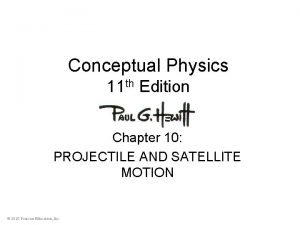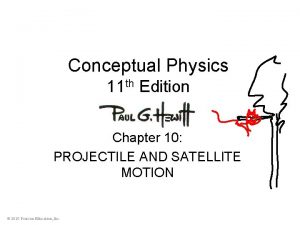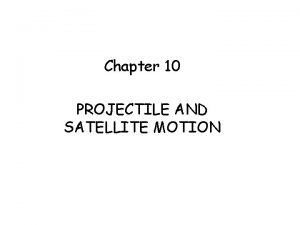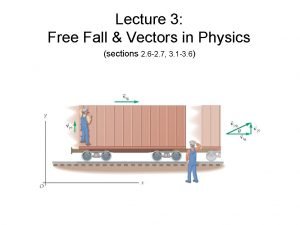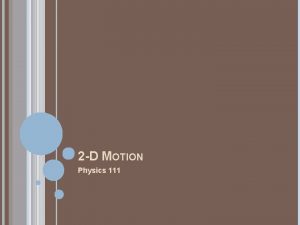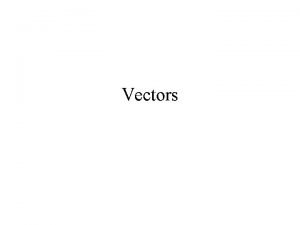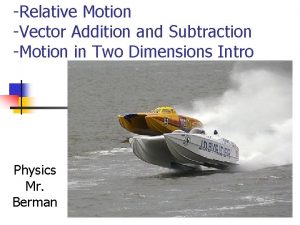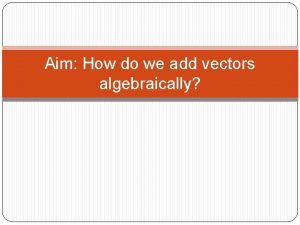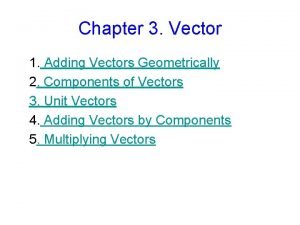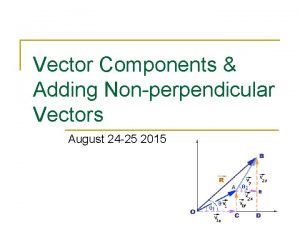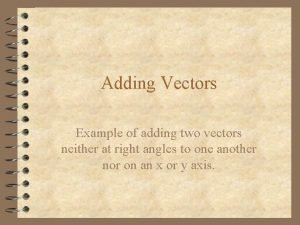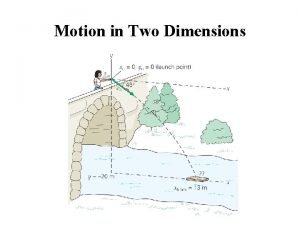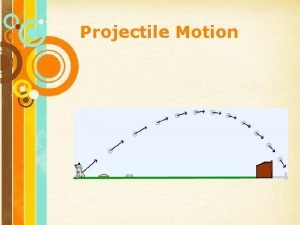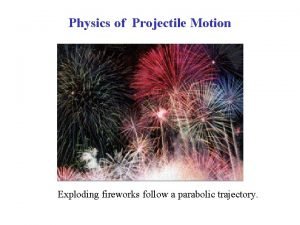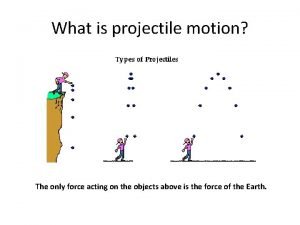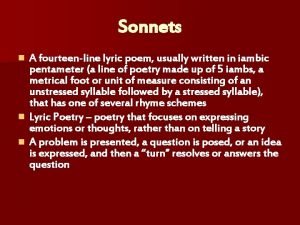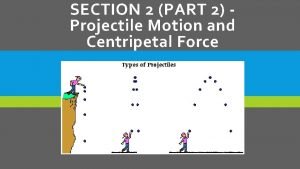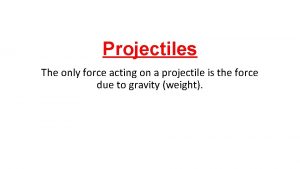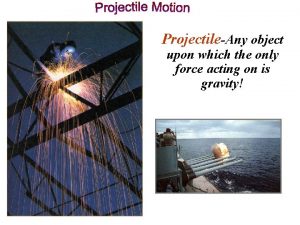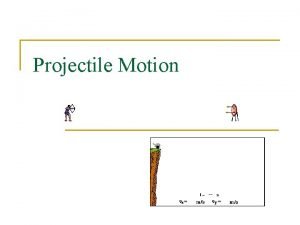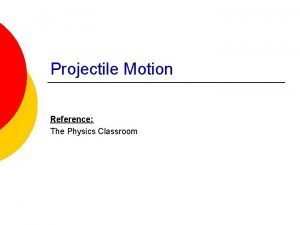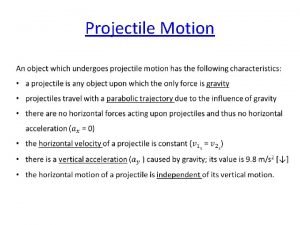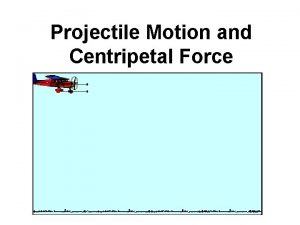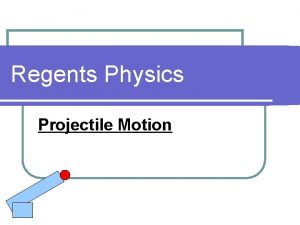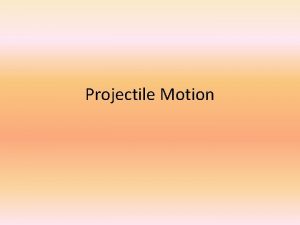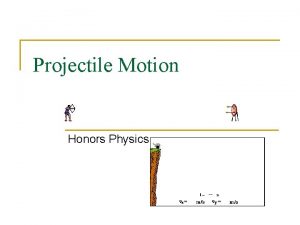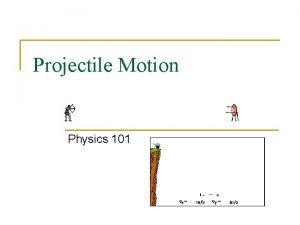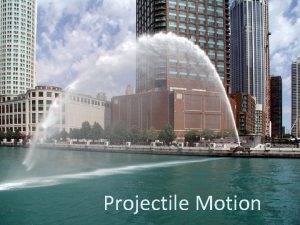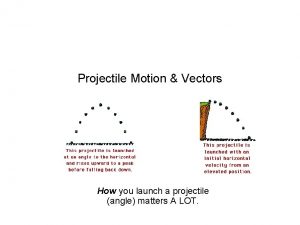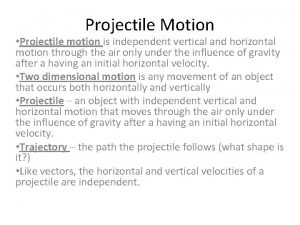Vectors and Projectile Motion Chapter 3 Adding Vectors


































- Slides: 34

Vectors and Projectile Motion Chapter 3

Adding Vectors When adding vectors that fall on the same line, using pluses and minuses is sufficient. When dealing with two dimensions, vector addition must be used. A complete answer includes magnitude, units, and a direction usually indicated by an angle.

Right Angle Vector Addition C=resultant, means sum of two vectors. 4 m 2 m In this case, Pythagorean theorem will solve for c. =63. 4 o c =4. 47 m If you walk 2 m north and then 4 m east, what is your displacement? In order to find , trig must be used. It is usually best to use the given sides, rather than the calculated side.

Steps for Adding Perpendicular Vectors Line vectors up head to tail. Draw the resultant. Find the resultant length using the Pythagorean theorem. Use trig to find the angle. Ensure that the angle measure has a distinct reference point, either by words or a picture.

Practice Problem A sailboat experiences a 5 m/s wind to the east while traveling 10 m/s downstream. Find the resulting net velocity 5 m/s 10 m/s

Adding more than two vectors Vectors can be added in any order. Subtracting a vector is the same as adding a vector that is the same length, but going the exact opposite direction. When drawing a picture, vectors may be rearranged into any order as long as their orientation is maintained.

Example

Practice What is the total displacement of the motion, assuming each block is 1 m long?

Vector direction Degrees on the unit circle Start on the positive x and move CCW for positive degrees and CW for negative degrees. Examples, 40 m @ 217°, 34 m/s @ -73° Compass direction 27° S of W Southwest would indicate a 45° Earth and space sciences use a system where north is 0° and one always has a positive angle and proceeds CW around the compass.

Adding vectors with random orientation Components-A set of vectors that have a sum equal to a given vector. Usually most useful to have components perpendicular to each other. Breaking up a vector, called resolution, is the exact opposite of adding two perpendicular vectors to find a resultant. Usually, components are along the x and y axis. x y

Component practice 32 m@67° 50 m@200° 14 m/s@-112° 6 m/s@-300°

Steps for solving vector problems Graphically represent the system to give yourself a check for your answer. Draw each vector individually. Using trig, find the x and y components of each vector. Add all the x components together and add all the y components together. Make a new diagram using the total x component and the total y component. Draw in the resultant and label a reference angle. Use the Pythagorean theorem and trig to find the resultant and angle

Example Problem 9 m, 45 o up from the horizontal 11 m, 18 o down from the horizontal

Splitting the Triangles Up 11 m, 18 o down from the horizontal 9 m, 45 o up from the horizontal x 2 y 1 45 o x 1 18 o y 2

x 2 y 1 45 o x 1 18 o y 2

Working with the first triangle 9 m, 45 o up from the horizontal y 1 45 o x 1

Working with the second triangle 11 m, 18 o down from the horizontal x 2 18 o y 2

Putting everything together c ytot xtot

Practice Find the resultant of the following vectors: 450 m @ 20 o 360 m @ 300 o 290 m @ 189 o 405 m @ 115 o

Projectile Motion

Horizontal and Vertical Motion

Things to remember for 2 D motion Vertical and horizontal motion are independent. When something is traveling through the air, ignore the effects of air resistance. There is nothing pushing or pulling a projectile horizontally, therefore ax=0. For vertical motion, gravity is causing the vertical acceleration, so ay=-9. 8 m/s 2. We will assume that projectiles landing at a height different from their initial height are always launched horizontally. Therefore, any initial velocity is an x piece. There is no y component for initial velocity.

Horizontal Components a=0

Vertical Components Viy=0 a=g

Cliff Problems A car drives off a 100 m cliff at a speed of 47 m/s. What is: The time it takes to hit the ground? It’s horizontal distance from the base of the cliff? It’s final velocity?

Identify Vertical and Horizontal Components Horizontal vi=47 m/s vf=47 m/s a=0 t=? x=? Vertical a=g=-9. 8 m/s 2 vi=0 y=100 m t=? vf=?

Part A Use y pieces because there is not enough information to solve for t using x components. Since the car stops moving horizontally at the same time it stops moving vertically, the t found using the y components can be used for the x components as well.

Part B

Part C The car is going both down and over at the end so vf has both x and y components. vfx= vix vfy must be calculated.

Part C Continued Put x and y components together and solve for both resultant and angle. vfx c vfy

Practice Problems A ball is thrown horizontally from the roof of a building 56 m tall and lands 45 m away from the base. What was the ball’s initial speed? An onion runs off of a building at a speed of 22. 2 m/s and lands 36. 0 m from the base of the building. How tall is the building?

Starting and Ending at the Same Height

Practice Problem A water balloon is shot from a slingshot at an angle of 21 o and with a velocity of 16 m/s. What is: The horizontal range? The time it’s in the air? It’s maximum height?

More Practice A long jumper leaves the ground at 30 o and travels 7. 8 m. How long is he in the air? A pilot drops a flaming bag of poo from a plane in an attempt to hit the roof of the high school. If the plane is traveling at 160 km/hr and is 160 m above the ground, how far before he is directly overhead should the pilot drop the bag?
 Conceptual physics projectile motion
Conceptual physics projectile motion Chapter 10 projectile and satellite motion
Chapter 10 projectile and satellite motion Chapter 10 projectile and satellite motion tossed ball
Chapter 10 projectile and satellite motion tossed ball Free fall
Free fall You are adding vectors of length 20 and 40 units
You are adding vectors of length 20 and 40 units Example of projectile motion
Example of projectile motion Which of these expresses a vector quantity
Which of these expresses a vector quantity Representing vectors
Representing vectors What is vector
What is vector Define relative velocity
Define relative velocity How do you add vectors algebraically
How do you add vectors algebraically Adding vectors geometrically
Adding vectors geometrically Components of a vector
Components of a vector Adding two vectors together
Adding two vectors together Horizontal and vertical projectile motion formulas
Horizontal and vertical projectile motion formulas Projectile motion ppt
Projectile motion ppt Aristotelian projectile motion examples
Aristotelian projectile motion examples 2d motion equations
2d motion equations Chapter 2 section 1 describing motion answer key
Chapter 2 section 1 describing motion answer key Measuring motion
Measuring motion Chapter 2 motion section 1 describing motion answer key
Chapter 2 motion section 1 describing motion answer key What is the only force acting on a projectile
What is the only force acting on a projectile Symmetrical projectile motion
Symmetrical projectile motion Acceleration vector projectile motion
Acceleration vector projectile motion A 14 line lyric poem is called
A 14 line lyric poem is called An object in projectile motion will follow which path?
An object in projectile motion will follow which path? What is the only force acting on a projectile?
What is the only force acting on a projectile? What is the only force acting on the projectile
What is the only force acting on the projectile What is projectil
What is projectil Physics classroom
Physics classroom Importance of projectile motion in our daily life
Importance of projectile motion in our daily life Vertical y horizontal
Vertical y horizontal Which describes an object in projectile motion?
Which describes an object in projectile motion? A projectile motion is a combination of
A projectile motion is a combination of Projectile motion tennis
Projectile motion tennis
